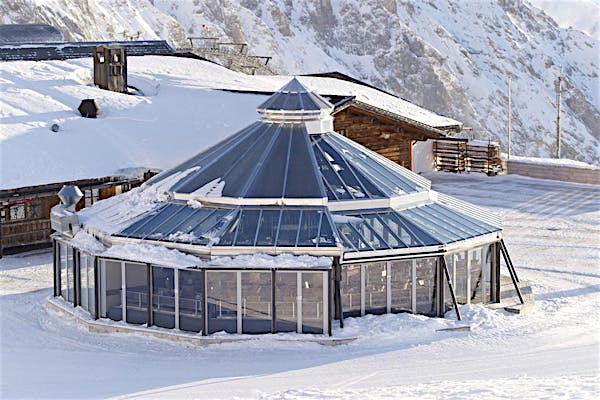
Open air classrooms were once the solution that helped decrease the spread of tuberculosis within schools in the early 20th century. When addressing health concerns today, this pioneering school design concept transforms traditional classrooms into healthy engaging environments with the assistance of flexible wall openings. Gone are the days of stuffy classrooms that recycle the same air throughout the school day. Along with historic evidence supporting the notion that an open air classroom provides a healthy stimulating environment, removing solid wall barriers was established as the solution that improved these teaching spaces. How then, can school design continue to improve an indoor-outdoor learning approach to ensure student’s health and information retention?

Open Air Classrooms: A Lesson from the Past
In the early 20th century, open air classrooms became fairly common in Northern Europe, originally designed to prevent, and combat the widespread rise of tuberculosis that occurred in the period leading up to the Second World War. Soon after, the first open air school opened in Providence, Rhode Island where its success at mitigating the spread of tuberculosis led to other schools adapting the solution within their campuses. School design focused on the concept that exposure to fresh air, good ventilation and exposure to the outside were paramount. Soon, these open air schools reported their students were gaining health with the open windows, even in lower temperatures.

A Solution for Student’s Health and Wellbeing in Learning Environments
Operable glass systems are capable of transforming a wide opening into a flexible solution that completely eliminates walls. In learning environments, the ability to transition a classroom to the outdoors is essential in maintaining student wellness and enhancing learning capabilities. The World Health Organization has reported that aerosols, small airborne particles, can linger in stagnant air for hours and thus helping transmits viruses indoors. Open air classrooms empathize the importance of fresh air circulation in learning environments in an effort to better engage students in the curriculum and keep them healthy. Enclosed classrooms trap and recycle the same air throughout the day, harboring the potential of an unhealthy environment. The consistent breathing of low-quality air can also lead to lack of focus, engagement and health problems in the future.

School environments, however, encompass more than just teaching spaces and can include libraries, gymnasiums, multipurpose rooms, and cafeterias. Opening glass walls are getting wider, taller and more customizable and the idea of open air classrooms can expand to other buildings within a school setting where constant air circulation is also of importance. Arizona Western College, pictured below, has eliminated enclosing walls with wide parallel openings on each side of their cafeteria. The two NanaWall SL70 folding glass wall systems completely open the space to fresh air and daylight.

Student’s Improvement in Attention and Retention
Opening glass walls, compared to static solid walls or windows, allow maximum amounts of daylight to enter a space. Open air classrooms featuring transparent operable systems have the advantage of allowing not only fresh air to enter the space but also extensive amounts of sunshine, even when closed. Studies have shown that children learn 20 to 26 percent faster with exposure to daylight. This stimulating experience helps in engaging students to the curriculum being presented while boosting moods and overall energy. Natural lighting, in combination with the constant flow of fresh air, ensures that students are obtaining the proper environment that encourages learning and the preservation of that information.

School Design Spotlight: TVT’s MAKER Building
Seeking to reinvent the school to meet 21st Century school design and utilize the outdoors as educational spaces, Tarbut V’Torah in Irvine, CA, added the MAKER science building to its campus. Meeting the modern standards of today’s learning environments, LPA Design Studios designed the MAKER building to be flexible. Tables, chairs, whiteboards, and even the walls are all mobile and encourage collaboration not only with each other, but with the outdoors. “This project expands on the original site, bringing the facilities and exterior spaces in-line with today’s 21st Century educational and instructional needs,” says project designer LPA Design Studios.

The open corner design of a 12 panel single track stacking HSW60 system eliminates fixed walls and completely opens one of the rooms in the MAKER building. The low profile saddle sill offers ADA compliance for the school setting and the individual glass panels smoothly glide around the corner and out of the way when opened. During school hours, and if the weather allows it, the opening glass walls glide away and immediately transform the space into an open air classroom—saturating the space with constant fresh air and daylight. Learn more about Tarbut Torah School project.

Final Thoughts
The copious benefits of open air classrooms in school design are endless. Student’s success and wellness in learning environments go hand in hand in ensuring the best educational experience available. The constant circulation of fresh air into these spaces eliminates the threat of spreading sickness and attention deficit in young learners. Opening glass walls are the flexible, ever-evolving solution that offers ease of operation and performance in any environment, completely eliminating walls and inviting the outdoors in.
Learn more about opening glass walls in learning environments.








